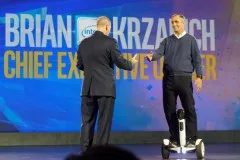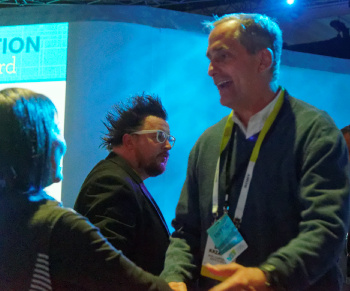 Krazanich was very relaxed before his keynote
Krazanich was very relaxed before his keynote
Brian Krzanich, CEO of Intel gave the main CES keynote this year.
When we arrived, on the seat was a wristband (the Pixmob) that had LEDs in it and was powered by the Intel Curie processor (aimed at IoT and wearable applications) and was intended to be used by audience members to “participate” in the event. Apparently there was more that the band could do if taken to the Intel booth. (although not much more, we thought).
Before the main talk was a short presentation by a visual artist that used VR and a virtual spray can to create 3D virtual graphics and also a jazz rock music performance using gestures to create the main sound.
Gary Shapiro of the CTA came on to make the introduction. He said that Intel always sets the frame for what CES discusses.
Finally, Krzanich came on to talk – on a hoverboard which was an interesting piece of risk taking in a live event. (Everything went pretty smoothly despite the many demoes during the event and Intel staff were “high fiving” each other at the end of the event).
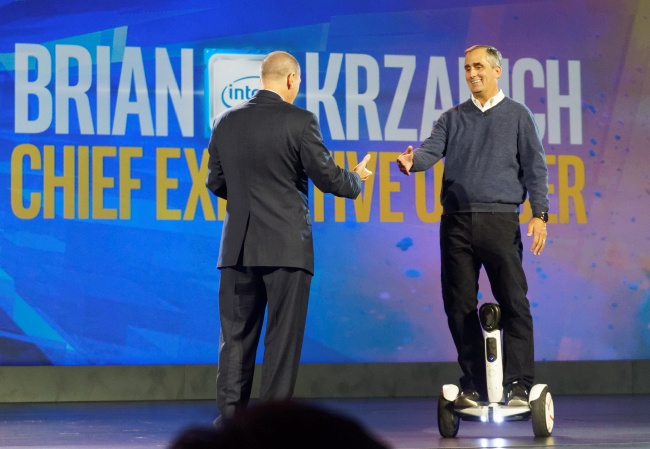 Krzanich arrived for his keynote on a Segway. Image:Meko Ltd
Krzanich arrived for his keynote on a Segway. Image:Meko Ltd
The world is becoming smart and connected but the next step is to add sensors, Krazanich said, for example by adding depth to cameras. This is the “sensorisation” of computing.
Krzanich showed a film made by Intel of drones “performing” music with shapes and colours created in the sky by a large number of drones, each independently controlled. This was an impressive effect – it was (almost) like electronic fireworks. It broke the world record for the number of drones. Krzanich said he’d like to get rid of the smell and danger if fireworks (I love the smell of fireworks – it’s so evocative. and part of the pleasure of fireworks is the potential danger, surely? – Man. Ed.).
Krzanich covered the opportunities in three areas:
- Sport & Gaming
- Health & wellness,
- Creativity
Gaming has already seen a lot of change with networking and the development of “eSports”. In Novmenber, Krzanich played in a tournament for game players, which he said that he actually trained for. He showed a new game, Ubisoft’s Rainbow Six Siege and introduced Stephanie Harvey (“Miss Harvey”), a professional game player to give a demo.
Next there was a demo of using the Intel RealSense technology to input Krzanich’s face and put the 3D face that was created onto a character in a game.
Krzanich said that Intel wants to extend the eSport experience to all sports. He showed FreeD or “Free Dimensional Video”. This is a new way to capture videos of sports. The capture creates a 3D version of the event and the 3D version can be viewed from any point. He showed a basketball game from a free perspective. The technology would bring “Replay” technologies to every sport globally, he claimed.
The Intel Curie chip starts shipping this quarter and costs less than $10. He showed how two chips could be mounted on a bmx bike to understand the complete movement of the bike in space and to get lots of data about motion and movement. This will really change a lot of issues in live sport as so many parameters can be measured. That will also help coaches to develop training plans.
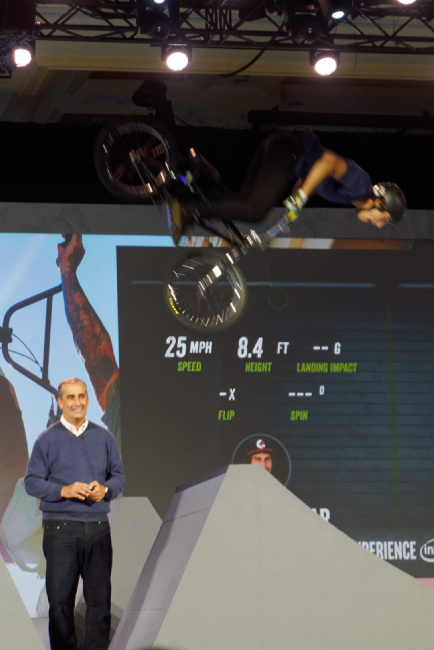 Krzanich had this BMX bike looping over him – note the data from Curie on
Krzanich had this BMX bike looping over him – note the data from Curie on
the back display. Image:Meko Ltd
The first time that the technology will be extensively is at the forthcoming X Games in Aspen. John Skippier from ESPN and co-chairman Disney Media Networks came on to endorse the move. He said that X games was the first to use drones, the first to use Gopros in sports coverage and now the first to use the Curie chips. Intel has also done a lot of work with Red Bull for the technology.
A “parkour” runner (Jason Paul) came somersaulting onto the stage and showed off how much data could be collected about the tricks and movements that he was making, including the force he was using, spin speeds and motion.
Krzanich then showed Intel’s technology being used in drones and has been shown before, using RealSense to navigate obstacles. This year, the next step has been to develop commercial products and the Yuneec TyphoonH will use Realsense and will have a 4K camera. It also has a display in the controller so that the pilot can see what the drone does. The use of Realsense means that collision avoidance can be integrated and there was a live demonstration of the drone following a mountain biker through a complex obstacle course, down the side of the hall where the event took place. The drone is more accessible this year as it is expected to be released during the first half of 2016 at “less than 2,000”.
Health & Wellness
Krzanich said that health and wellness are the “new frontier for innovation”. He demonstrated a new sports training application which will be sold under the Oakley brand as the Radar Pace. This uses “smart eyewear” that uses audio recognition and output to respond to the individual runner to help them train. Directions and instructions that are unique to the current sesson are given. The product is aimed at cyclists and runners and can respond to questions such as “How’s my power” and will give advice such as “I can tell this is too easy for you, so let’s work a little harder”. (The Oakley Radar Pace did not seem to have a display, but Intel bought Recon Instruments last year, so there is speculation that eventually, it will. Man. Ed.)
Craig Alexander is a 3X Ironman World Champion and endorsed the product, which will start to ship in late 2016.
Rob Demartini is from New Balance where he is president & CEO. New Balance manufactures sports goods including trainers in US (cue a cheer from the audience). Demartini said that athletes don’t want to carry cellphones and wires and New Balance has started a new division to cover “digital sport”. In April, New Balance will launch custom performance running shoes made by 3D printing and will then introduce 3D printing in store and maybe later at home. The shoes can be designed around feet measured by RealSense. Krzanich said that he was wearing the new trainers at the show and that they were “very comfortable”.
The company will also introduce a new smartwatch towards the end of the year.
Next Krzanich said that “Health & Safety has gone Tech Mad”. He showed the Daqri Smart Helmet which uses a 6G MCore M7 processor in the helmet and has RealSense. There was a demonstration of augmented reality with the user being shown the information needed for repairs and maintenance. The RealSense sensor could detect the configuration of, in this example, pipework, to indicate to the user what to do with controls and parts, by superimposing data and animations on the display. The helmet also has a thermal camera integrated so that it can track heat issues in the environment. The helmet starts shipping immediately.
Creative Experience
Krzanich then turned to creative use of the company’s technology. For music, he introduced AR Rahman – who created the music for “Slum Dog Millionare” and other Bollywood productions. He showed how he has used Curie for about a year in arm/hand bands to input to an audio synthesiser (using Midi ) that means that he can build “virtual instruments”, including an “air guitar” that makes a real noise!
Intel is in partnership with the Recording Academy and the “Grammys”. Intel is also working with the “Haus of Gaga” and Lady Gaga was shown in a video and technology will be shown around the Grammys in February.
Next, Krzanich showed a new small Segway-type “personal transporter” that has been made by Xiaomi subsidiary, Ninebot, can have extensions added including Realsense (of course) so that it could navigate around furniture in real time. So, for example, it could be used to see who has just entered the front door. The robot is extendible and can have arms added for other functions. It can use the camera to follow a person.
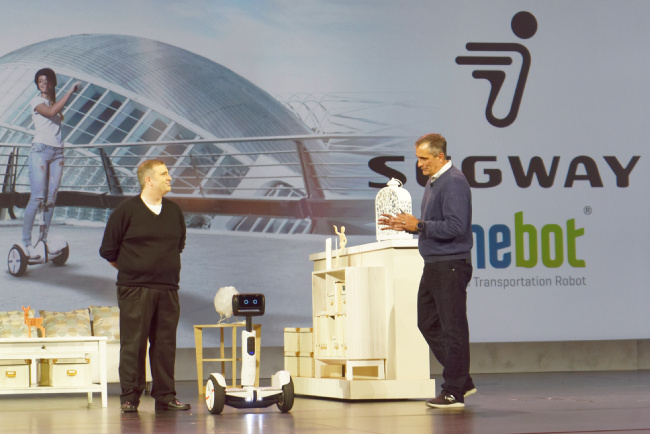 Intel showed this Segway Ninebot which can be converted to a robot
Intel showed this Segway Ninebot which can be converted to a robot
Next the topic turned to fashion and Becca Mccharen, CEO of Chromat came onto the stage. She showed electronics integrated into fashion with practical and also style-centric applications. Clothing shown included a “self ventilating bras” that can adjust according to the temperature and what might best be described as “wings” that were on the back of a dress. The wings were part of an “adreniline dress” that reacts to the mood of the user by changing shape.
Intel is fond of the “Maker” movement in the US and has been working with broadcasters to develop a new reality TV show called “America’s Greatest Makers” where people from the “Maker” movement compete for a $1 million prize.
Another new application that uses electronics is the “Grush” toothbrush game – children get to brush off the monsters that are shown on their teeth!
Finally, at the end of the long keynote (around 1 hour 40 minutes) he concluded by talking about Intel’s policy to increase diversity in its workforce and to eliminate the use of “conflict minerals” in all of Intel’s products.
The presentation concluded with a performance of “Jai Ho” byt AH Rahman, from the Slumdog Millionaire film. It looked as though Intel had been expecting the audience to participate by using the bands that had been supplied to reinforce certain points of the song, but we only realised this when we noticed a couple of people in the front row doing this, so the crowd effect that had been hoped for didn’t materialise.
Despite the lack of this audience involvement, the keynote was impressive especially in the degree of risk-taking in the impressive live demoes, but just ten minutes or so too long, in our view.
Analyst Comment
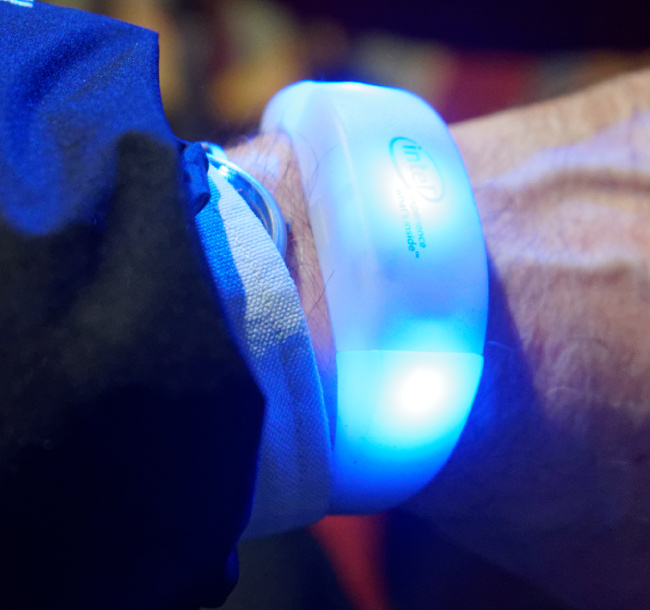 We took our Pixmob band (right) home and had some fun connecting it to an app (Pixphony) that is available for Android and iOS to allow the band to make music by creating midi data. The app is clearly an “alpha”, but we were pleased to get a prompt mail back from the development group to some queries about it. (BR)
We took our Pixmob band (right) home and had some fun connecting it to an app (Pixphony) that is available for Android and iOS to allow the band to make music by creating midi data. The app is clearly an “alpha”, but we were pleased to get a prompt mail back from the development group to some queries about it. (BR)

